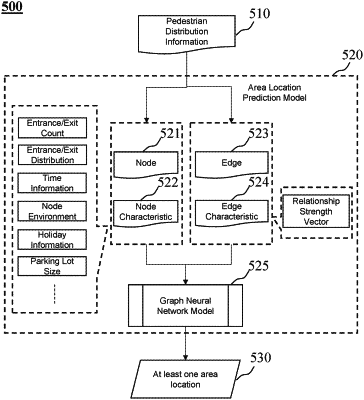| CPC G06Q 10/063 (2013.01) [G06F 16/25 (2019.01); G06N 3/04 (2013.01); G06Q 50/26 (2013.01)] | 9 Claims |

|
8. An Internet of Things system for managing a public place in a smart city, comprising a user platform, a service platform, a public place management platform, a sensor network platform, and an object platform, the management platform of the public place includes a management sub-platform, a management sub-platform database, wherein the public place management platform is configured to perform the following operations including:
obtaining pedestrian distribution information in a preset area during a current time period via network from a storage device, including:
a processor of a sensor network sub-platform of the sensor network platform processing a plurality of videos based on a recognition model;
obtaining population flow information of a plurality of preset areas in the plurality of videos,
wherein the recognition model includes a Yolo model that recognizes users in the plurality of videos and the recognition model is obtained through a training process, comprising:
generating a plurality of first training samples and first labels; wherein the plurality of first training samples include sample videos obtained based on historical surveillance videos, the first labels include a sample object from the users and a category corresponding to an object box;
inputting the plurality of first training samples with labels into an initial recognition model;
updating parameters of the initial recognition model through training; and
obtaining the recognition model when the initial recognition model satisfies a preset condition;
obtaining pedestrian distribution information in the preset area during a current time period based on the population flow information; and
receiving the pedestrian distribution information transmitted from the sensor network sub-platform;
determining, based on the pedestrian distribution information, at least one area location in the preset area for a future time period, a population flow load of the area location being greater than a first threshold, wherein the at least one area location is determined by processing the pedestrian distribution information through an area location prediction model, the area location prediction model includes a graph neural network model, and the area location prediction model is trained by the public place management platform according to a machine learning algorithm based on at least one second training sample and at least one second label, wherein each second training sample includes sample pedestrian distribution information, and each second label is a sample area location that is determined by an actual population flow load of the preset area in the sample pedestrian distribution information, and generating the sample area location including: the processing device of public place management platform designating an area location that the actual population flow load of the preset area in the sample pedestrian distribution information is greater than the first threshold as the sample area location;
a graph input into the graph neural network model includes at least two nodes and at least one edge, each of the at least two nodes includes at least one public place site, and the at least one edge includes a relationship between the at least two nodes;
a node characteristic of each node includes a count of entrances and exits of the at least one public place site, distribution positions of the entrances and the exits, time information, node environment information, holiday information, or a size of a parking lot;
an edge characteristic of the at least one edge includes a relationship strength vector, wherein the relationship strength vector reflects a relationship strength between two nodes, and the relationship strength vector is determined from a plurality of vectors, wherein the plurality of vectors include distance strength vectors, location strength vectors, and category strength vectors;
the node characteristic includes surrounding traffic flow;
an output of the graph neural network model is an area location that the population flow load is greater than the first threshold, and the area location is determined based on the correlation of each node in the graph composed of nodes and edges;
determining, based on the area location, prompt information; and
feedbacking the prompt information to a user terminal of the user platform through a service platform via network.
|